
Exposition of the Museum of Cosmonautics (Moscow, VDNH)
We are used to perceiving space through text and photographs here, at Hiktaimes, and on many other resources, and meanwhile, the entire Soviet, now Russian history of space exploration is hundreds of thousands of different things that can be seen, touched, felt.
The most important thing that can be comprehended by studying the artifacts of the past is ideas. Layouts created from drawings and drawings, as well as real things astronauts make a strong impression. They show how to achieve the impossible with limited resources, as well as with what grace, engineers solved complex technical problems.
In the collections of the Polytechnic and other museums are stored hundreds of rare artifacts and not all of them are available at exhibitions. Some are just waiting in the wings, others are almost forgotten.
Spaceship Tsiolkovsky
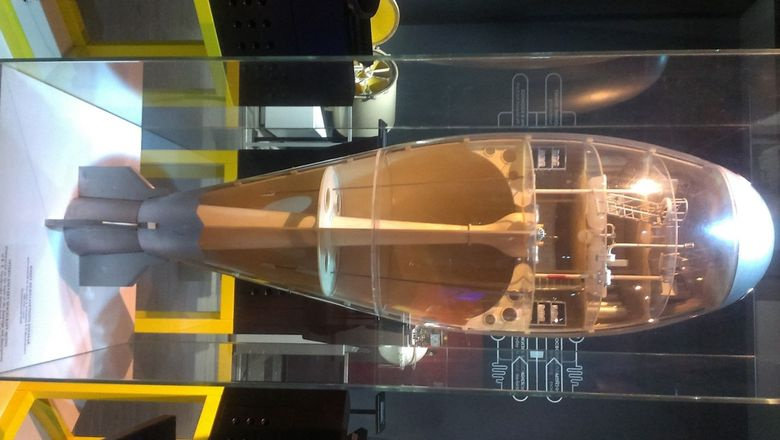
Layout. The exhibition "Russia makes itself." There is also a permanent exhibition at the Space Museum.
At the beginning of the twentieth century, studying the theoretical possibility of space flight, Tsiolkovsky offered his vision of the future interplanetary spacecraft. In 1963, on the basis of the surviving sketches, the model of this ship made of metal and plastic was created by the engineers of the Moscow Experimental Experimental Factory of visual aids and demonstration equipment.
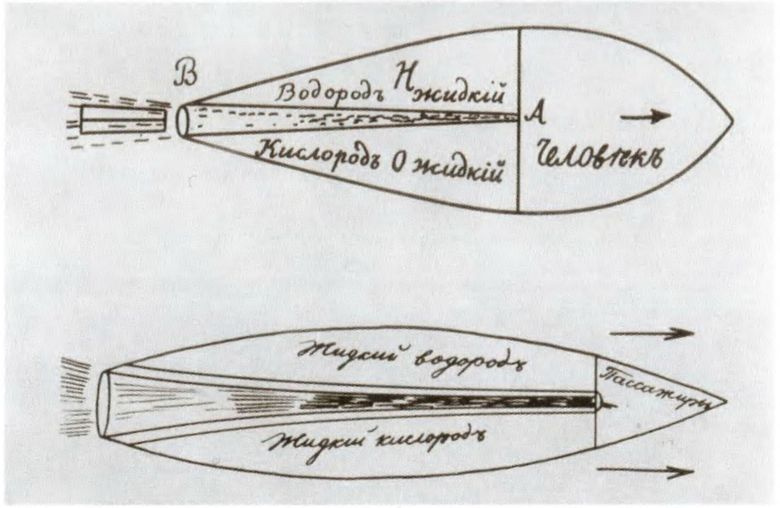
One of the interplanetary spacecraft schemes from the work of Tsiolkovsky "Study of the world spaces with jet instruments"
A source
According to Tsiolkovsky, the ship hull should be divided into two main zones: the lower compartment for an engine with fuel tanks and the upper capacious residential zone. The upper part of the ship (it is in the photo of the layout located on the right) is intended for storing food and water. In the next block is a manual control, spacesuits and the gateway to the spacewalk.
Anti-overload baths are installed in the middle section, filled with a liquid of a certain density to neutralize the harmful effects of acceleration. In the two lower compartments are pumps for supplying fuel components, tanks with fuel and oxidant, as well as a combustion chamber.
Helioketoplan
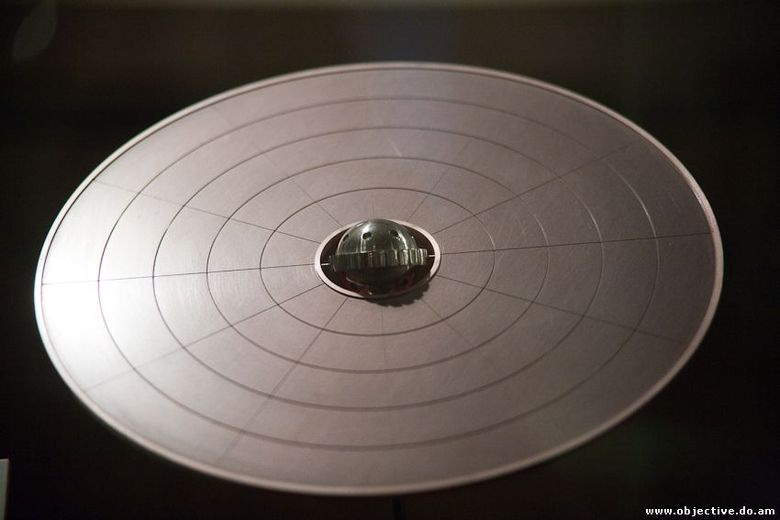
Model Helioketoplan was created in 1974 at a scale of 1: 100
Photo source
Valentin Glushko, one of the pioneers of rocket and space technology, the founder of the Soviet liquid-propellant rocket engine, in 1929 proposed the project of the interplanetary spacecraft Helioketoplan. The ship was supposed to use solar energy, which generates electric current to explode solid (metal wires) or liquid (mercury or electrically conductive solutions) fuel.
The cabin of the Helioketoplane was a sphere with a diameter of 2.6 m, along the perimeter of which 24 electric rocket engines were placed. For capturing and converting solar energy, the ship was equipped with thermoelements located on a disk with a diameter of 20 m.
The first liquid rocket engine (LRE)
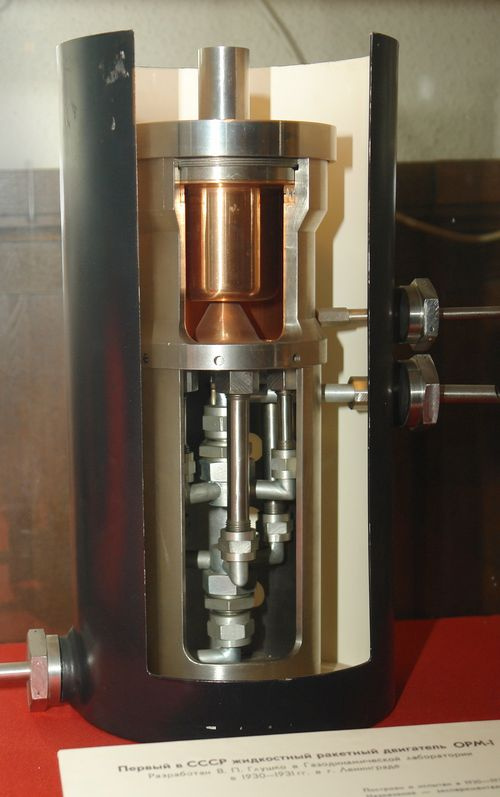
Engine sectional view, presented at the Museum of Cosmonautics and Rocket Technology (St. Petersburg)
The first Russian ORM rocket engine (an experienced rocket engine) and ORM-1 were built and tested in the Gas Dynamics Laboratory in 1930–31. Valentin Glushko.
It is interesting that in parallel with the work of Glushko there was the less well-known, but no less significant project of Friedrich Arturovich Zander, the inventor, student and colleague of Tsiolkovsky. The OR-1 engine, which worked on air-gasoline fuel, was created on the basis of a blowtorch, which had to be equipped with a special nozzle, and developed traction more than ORM-1 Glushko.
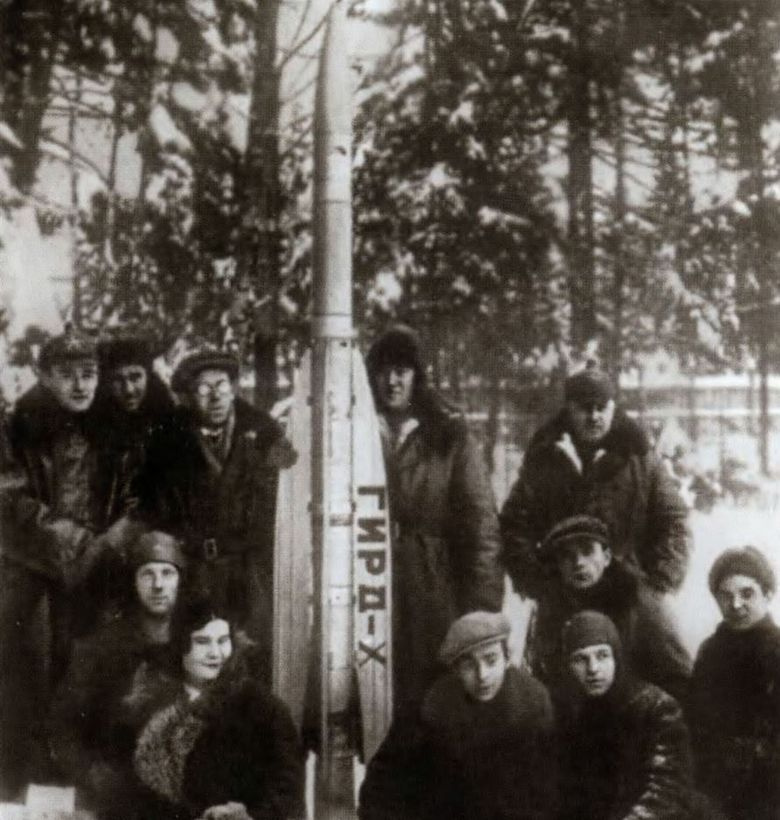
S.P. Korolev and the employees of the GIRD (Group for the Study of Jet Propulsion) before launching
A source
In 1933, Zander built a more advanced LRE OR-2. The OR-1 and OR-2 engines remained experimental, but Zander’s designs were used to create the rocket engine of the first Soviet GIRD-X liquid-propellant rocket engine.
Canine spacesuit
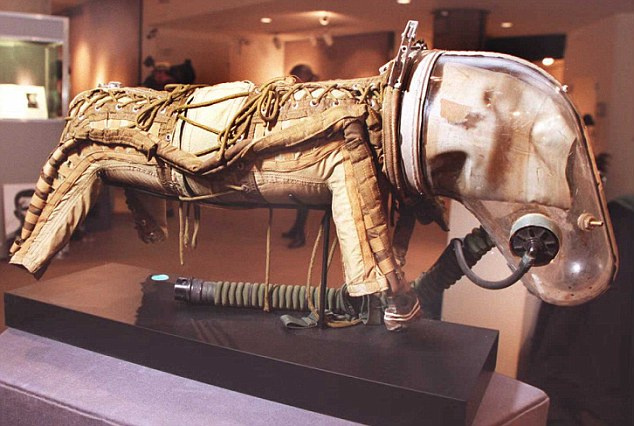
One of the first spacesuits with a plug-in breathing apparatus for dogs, made in the USSR in the 50s of the last century. Exhibited at Leicester National Space Center (UK)
A source
Yes, Belka and Strelka had special space clothes. Moreover, in special costumes, the dogs also underwent preflight training. Laika and other astronauts also didn’t fly naked.
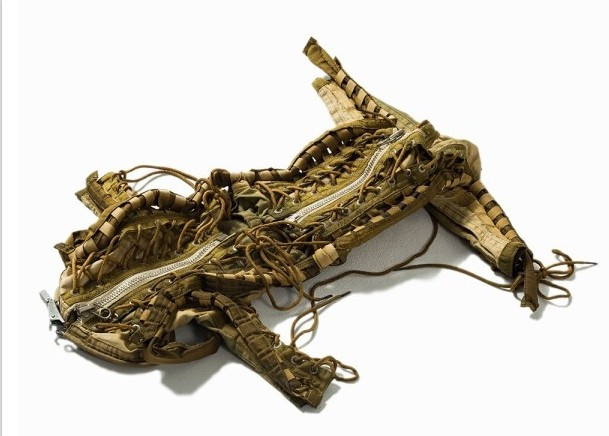
Clothing for a dog-astronaut in the "loose" form
A source
Adjustable thanks to the special lines on the main part and the “sleeves” for the paws, the space doggy costume is made of a combination of cotton, nylon, aluminum and rubber.
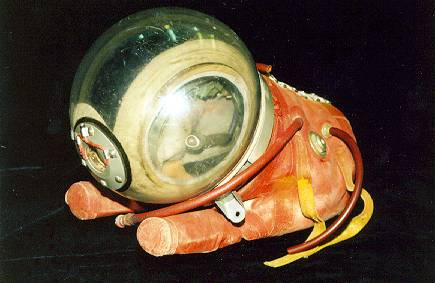
Spacesuit. Exhibit of the Russian Museum of Cosmonautics
There were even canine suits for ejecting from the stratosphere, as well as for flying into a pressurized geophysical rocket cabin. It is a construction of an airtight bag with two deaf "sleeves" for the front paws of an animal and a plexiglas-shaped helmet.
Have you ever wondered how dogs in orbit went to the toilet? Yes, this problem was also solved by engineers using a special waste disposal facility (stored in the Polytechnic Museum), mounted under the tail.
The dashboard of the ship "Vostok-1"
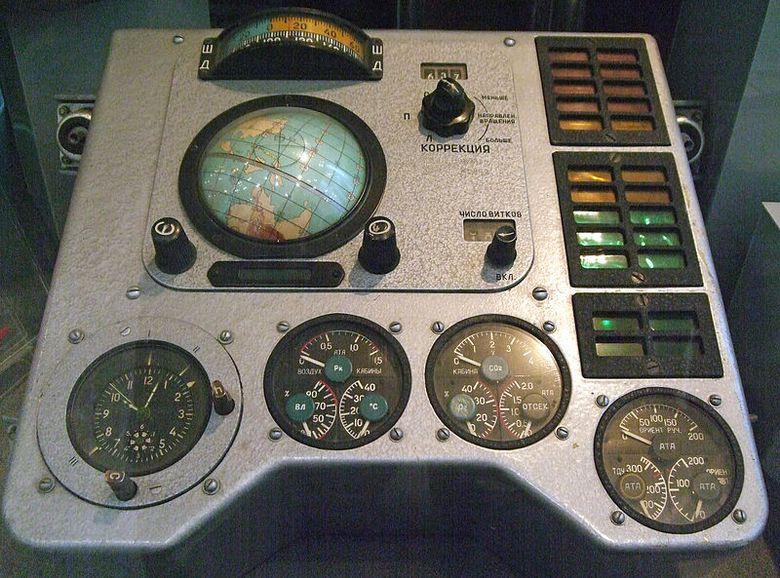
Photos from the Central Museum of the Armed Forces
The instrument panel of the ship of Y. Gagarin (and after him and some others) looked exactly like this. In addition to it, the control system of the Vostok ship included the PU-2-3KA remote control and the RU-1B orientation control knob. The globe with clockwork showed the current position of the ship above the Earth and the predicted landing point.
Other important devices that provide communication, control, and livelihoods have survived to this day: a keyboard that converts alphabetic keys to Morse codes for controlling communications equipment, air regeneration units, pressure regulators, gas analyzers, water supply systems, and sanitary cleaning devices. All these devices are not only of historical value, but also clearly demonstrate complex engineering solutions.
Phantom mannequin
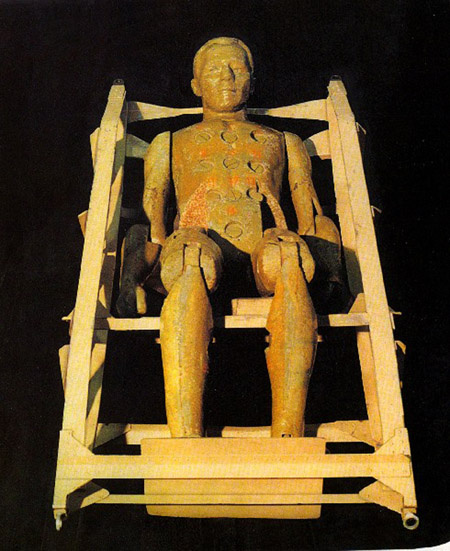
Source of Stored in the Polytechnic Museum
In 1968, the Institute of Medical and Biological Problems of the USSR Academy of Sciences from wheat grains, sawdust and resin created a human body model (height 170 cm, weight 70 kg) to study the effects of ionizing radiation in near-Earth space. This unusual material was chosen because of one important parameter - the grain transmits radiation in the same way as the tissues of the human body. In the locations of vital human organs, 20 channels for various dosimeters were made.
FM-2 twice participated in space missions: in 1969, in the Zond-7 mission, he flew around the moon, and in 1970, on the Kosmos-368 satellite, he landed on Earth.
Oven
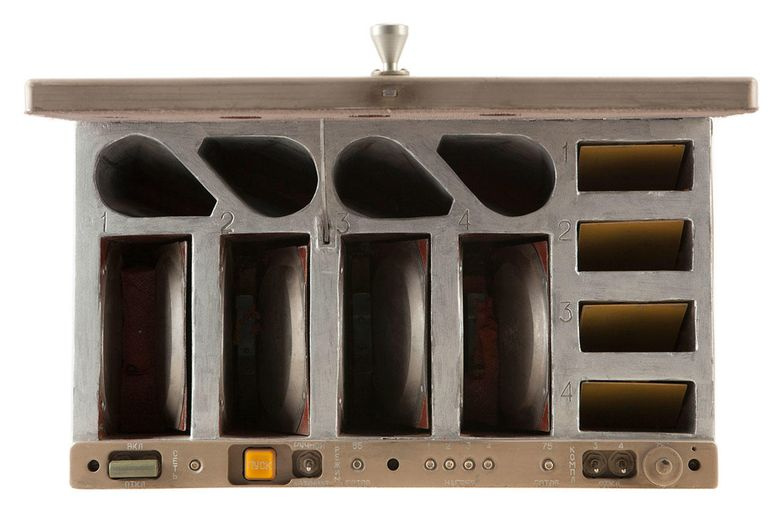
Photo source . From the collection of the Polytechnic Museum
It is customary to think that the cosmonauts in the USSR simply squeezed the tubes of nourishing space food into themselves and were happy. And so it was until the period of stay outside the zone of gravity has increased.
In 1988, the All-Union Research and Experimental Design Institute of Food Engineering developed the A1-EPT on-board electric oven with pockets for tubes and cans. The oven was created for use at the Salyut and Mir orbital stations.
Unrealized projects

Lunar ship at the opening of the exhibition "Cosmos: the birth of a new era." Source of One of the flight-ready modules was temporarily provided by the Moscow Aviation Institute for display at the exhibition.
Everything that you saw above was somehow used in our space industry. But it also created a lot of things that were on the sidelines of history. Among the forgotten large-scale projects was the moon landing program.
The LK-3 landing module (Lunar Ship), built in the early 1970s, was supposed to deliver one cosmonaut to the Moon. LK consisted of a sealed cabin, a compartment with orientation engines with a passive docking unit, an instrument compartment, a lunar landing unit (LPA) and a rocket unit. The manual control system was built on the basis of an on-board digital computer and allowed the astronaut to independently choose the landing site visually through a special window.
LC was successfully launched three times in an unmanned version into the Earth's orbit. However, the failures related to the testing of the H-1 rocket, intended to launch a LC into the lunar orbit, led to the closure of the Soviet lunar program. At the moment in Russia there are five LC modules.
Where to look
In addition to the obvious thought - go to the museum - you should pay attention to the project " Cosmos: the birth of a new era ", for which the designers meticulously re-painted the models of some iconic exhibits from the collection of the Polytechnic Museum.